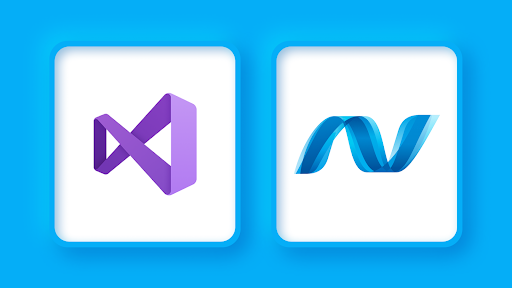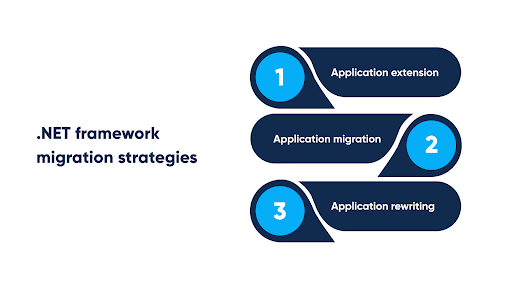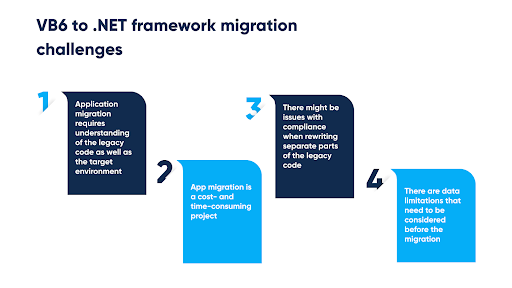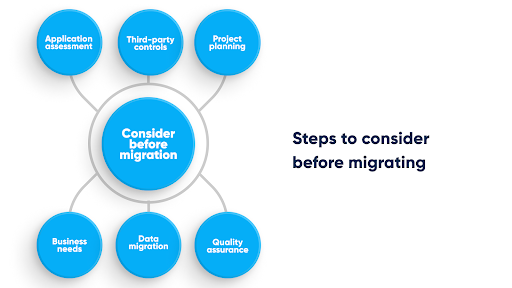Main Challenges of Migrating from VB6 to .NET

Main Challenges of Migrating from VB6 to .NET
Why migrate from VB6 to .NET? This article reviews the most relevant information on Virtual Basic and the .NET framework, the common migration challenges a business can face, and the crucial factors to consider before migrating.
Virtual Basic was created by Microsoft in 1991 and rapidly became popular. The event-driven coding language allowed engineers to modify code parts by dragging and dropping objects.
However, today, many apps built on Virtual Basic are migrated to the .NET framework. But what about the programming language makes the migration so necessary?

Visuals by Abto Software
Find expert development companies on The Manifest to start your next project.
What is Virtual Basic?
Virtual Basic is an object-oriented, event-driven programming language first introduced in 1991. It features simple syntax, which makes it a perfect environment even for inexperienced engineers.
Virtual Basic by Microsoft is a so-called RAD (Rapid Application Development system). It’s used to design simple prototypes, which are later rewritten to be more complex and efficient.
Why Migrate Virtual Basic 6.0 to .NET framework?
The final VB version was released in 1998. In 2008, VB’s support was discontinued.
What does this mean for companies with internal applications built with Virtual Basic?
Today, companies still using Virtual Basic 6.0 IDE are forced to migrate internal applications because the programming language is no longer supported. A still available option to those companies is migration to the .NET framework.
There is no completely accurate strategy to migrate from VB6 to .NET. Such a complex process involves significant manual re-writing and should be done by professionals with expertise in .NET.
Virtual Basic Security Vulnerabilities
If you’re still using Virtual Basic, you should be aware that it might unexpectedly stop running. It’s support, identified as low priority, is not verified extensively.
In 2019, a BlueKeep security vulnerability was found in the Microsoft RDP. Soon after, a patch was released, but it broke the core functionality of the programming tool.
The issue is addressing Windows 10, Windows 7, Windows 8.1, and corresponding server versions. Regardless of the cause for the emerged problem, this issue is a good reason to stop deploying the released patches.
It took several days for the Microsoft Corporation to address the BlueKeep security vulnerability. Users were left with two options – don’t run VB-based applications or don’t install any BlueKeep-related updates allowing your system to be vulnerable to viruses.
At the same time, the US National Security Agency and Microsoft stated that BlueKeep attacks are similar in scale to the WannaCry ransomware. The malicious WannaCry virus encrypted the user’s whole hard drive and demanded a ransom in bitcoins.
Is Virtual Basic Already Outdated?
Users deploying VB6 apps might have to cope with cryptic error messages and crashes resulting in data loss. The core VB functionality might work but implemented third-party components, such as OCX/ActiveX controls, might stop working.
Users are usually advised to contact original vendors. But the thing is, these vendors also don’t provide support for most of their old programs.
Eventually, companies will face no choice but to rewrite applications. Otherwise, it might get quite expensive. Take the recent 2020 case with the US government systems working on COBOL. Resolving long-postponed problems is way more costly than resolving those problems on time.
One more thing worth mentioning is old architecture approaches used with outdated languages. “Spaghetti code” drastically increases the complexity of applications.
And, as if that’s not enough, such apps are usually poorly documented. No wonder reverse engineering of such old applications has earned the name “software archeology.”
.NET Framework Migration Strategies
Those companies still using VB6-based solutions have the choice between three options:
Let’s dive deeper into this topic.

1. Application Extension
This strategy is most suitable if:
- The application is working.
- The described above issues are acceptable.
- New features have to be developed with fewer resources allocated.
Using .NET, additional modules can be easily implemented. The engineers can leave the legacy as is while extending it with extra features. Old modules that are still relevant can also be migrated to .NET. This is the so-called “strangler” pattern.
Pros and Cons of Application Extension
The main pros of application extension:
- It is the most cost- and time-efficient approach.
- The application is being extended gradually, which means instant benefits from investments.
The cons:
- The VB6-based application parts are prone to vulnerabilities.
2. Application Migration
This option is best for you in case:
- The application is unstable.
- The frequently emerging errors affect the overall user experience and cause data loss.
- All internal business processes are tuned to the desktop experience.
Pros and Cons of Application Migration
The main pros of application migration:
- The similarity of platforms allows for preserving the everyday user experience.
- The application is free from vulnerabilities.
The cons:
- Poor VB6 architecture choices might be automatically inherited from the original code.
- New functionality can only be added after a base application is developed.
3. Application Rewriting
Turn to this strategy in case:
- The migration is from the legacy desktop VB6 application to the web or cloud.
- You want to extend market share.
- The application is outdated and does not cover your core business needs.
Backed up by knowledge and experience in rewriting legacy applications, Abto Software earlier implemented this approach for a retail company. Take a look at the transfer of the legacy ERP to the web.
Pros and Cons of Application Rewriting
The main pros of application rewriting:
- It’s the only way to go when transitioning from desktop to web and mobile.
- Architecture written from scratch using today’s modern approaches provides cheaper development and makes support expenses more reasonable in the long run.
The cons:
- This strategy requires more extensive investments than the two previously mentioned approaches. However, it is justified by the future benefits.
- This approach requires more extensive testing.
VB6 to .NET framework migration challenges
The main VB6 to .NET framework migration challenges can be reduced to the following:
- Application migration requires a deep understanding of the legacy code and the target environment
- App migration is a cost- and time-consuming project
- There might be issues with compliance when rewriting separate parts of the legacy code
- Some data limitations need to be considered before the migration

To make the migration process as smooth as possible, the team must ensure the code is prepared and won’t need improvement.
6 Steps to Consider Before Migrating to .NET
Here are the steps to consider before migrating an application:

1. Application Assessment
Perform a thorough assessment of the source code. Cleaning up before migrating saves time and costs allocated to critical operational processes.
2. Implemented Third-Party Controls Check
Most of the extra controls built-in in VB6 applications aren’t compatible with the .NET ecosystem. Using those controls might decrease the application’s overall performance and speed.
3. Project Planning
Before migration, determine your project’s scope and assemble both legacy and application being developed. Detail the functional requirements, get the necessary tools, and choose a reliable tech partner.
4. Choosing a Suitable Strategy Based on Business Needs
VB6 to .NET migration, depending on the core business needs, can be performed using different approaches. Before migrating, you have to choose whether to:
- Extend the app’s functionality
- Migrate
- Rewrite
5. Data Migration
The engineers will have to migrate collected data by creating a database and resizing its structure to ensure high performance.
6. Quality Assurance
At least one-third of all project resources should be allocated to quality assurance and fixing emerging errors.
Migrate from VB6 to .NET for Scalability
Business growth demands scalability, and companies all around the globe are going web, mobile, and cloud. These are either very expensive or even downright impossible when using Virtual Basic.
VB6 to .NET migration is necessary for those who want to stay highly competitive in demanding markets. The modern .NET framework is cross-platform, flexible in deployment, easy to maintain, and cost-efficient.
Here are some things to keep in mind:
- Migrate to functional equivalence
If you have decided to migrate your application, there is significant value in the application’s logic. Since you might depend on it, leveraging the investments already made is essential.
- Decide on how to validate the functional equivalence
The project should have measurable criteria to validate the results. In our team’s experience, the best option is to prepare test cases to run first on the legacy and then on the new application to validate the migration.
Another thing, app migration is complex and demands both source and target platform understanding. Therefore, companies should entrust this process to professionals.
Looking for the right professional team for the job? Connect with a development company on The Manifest.
